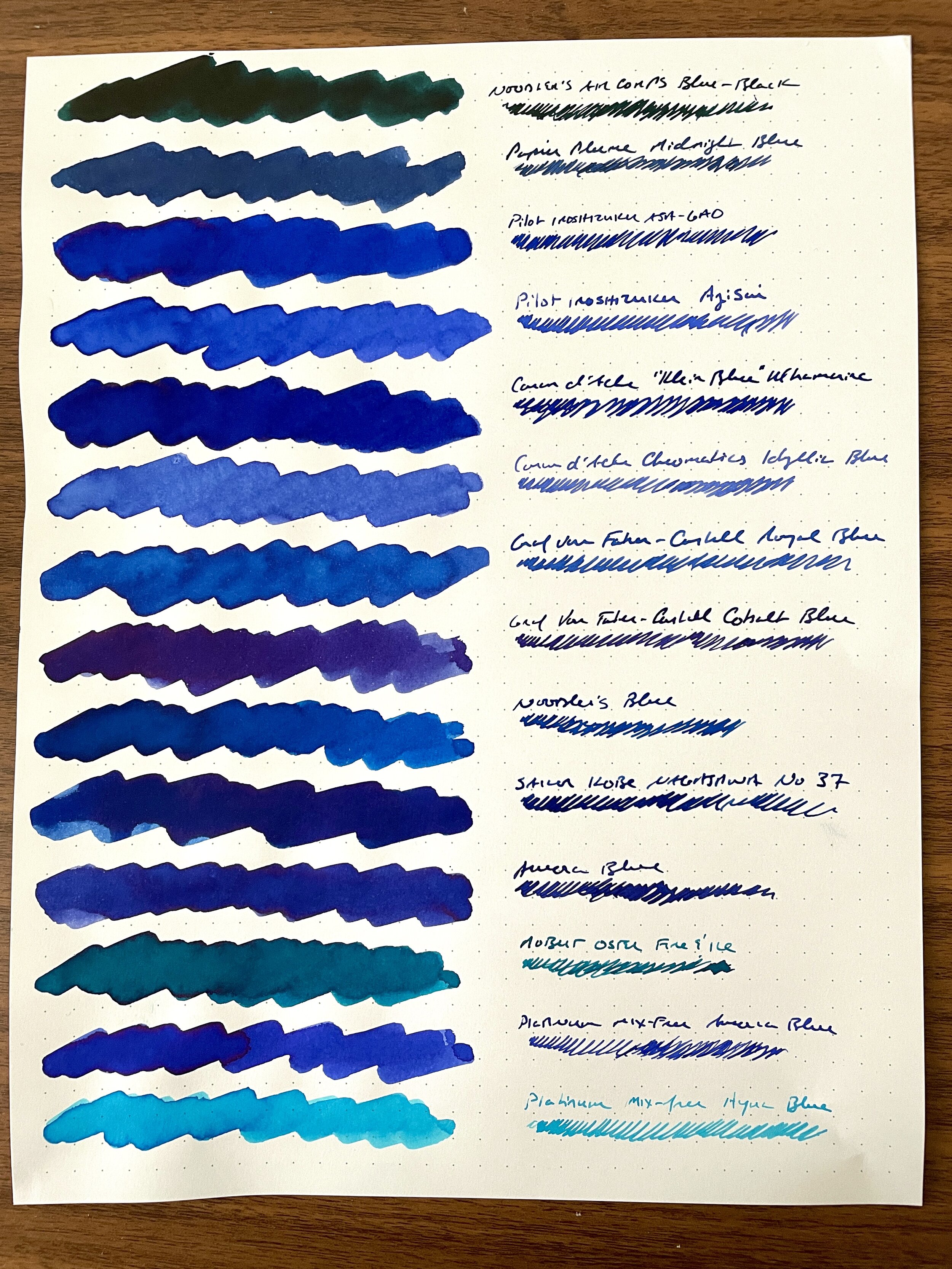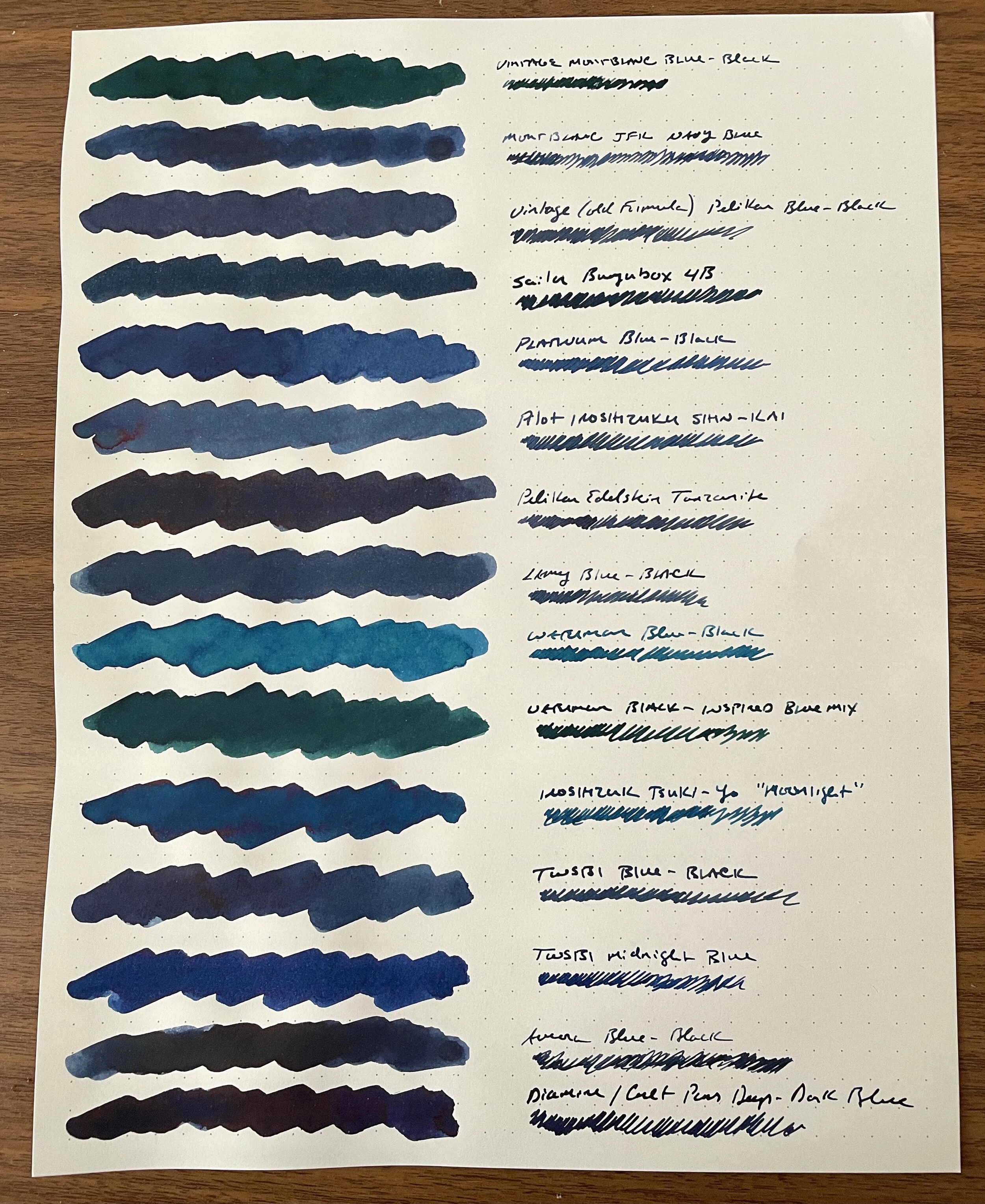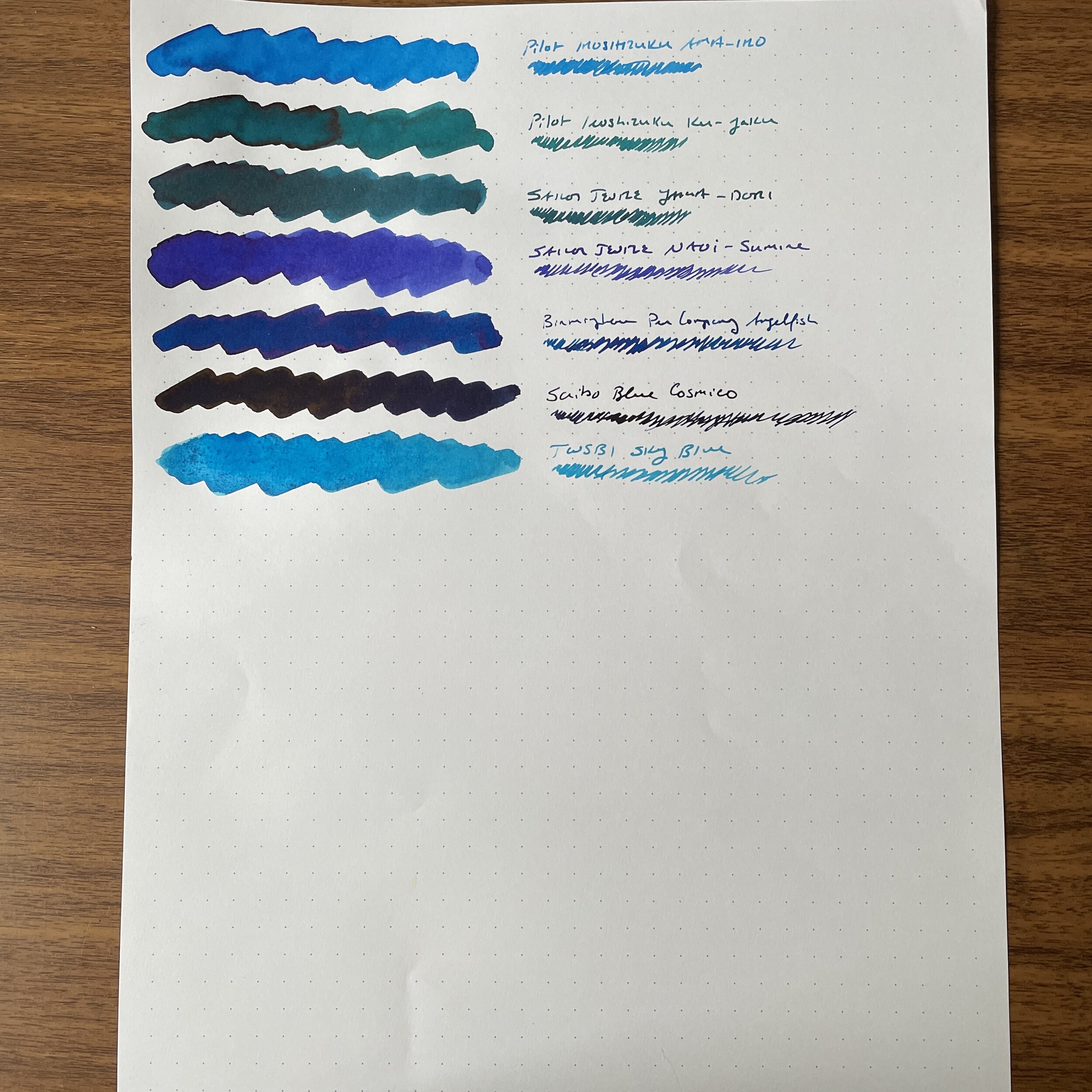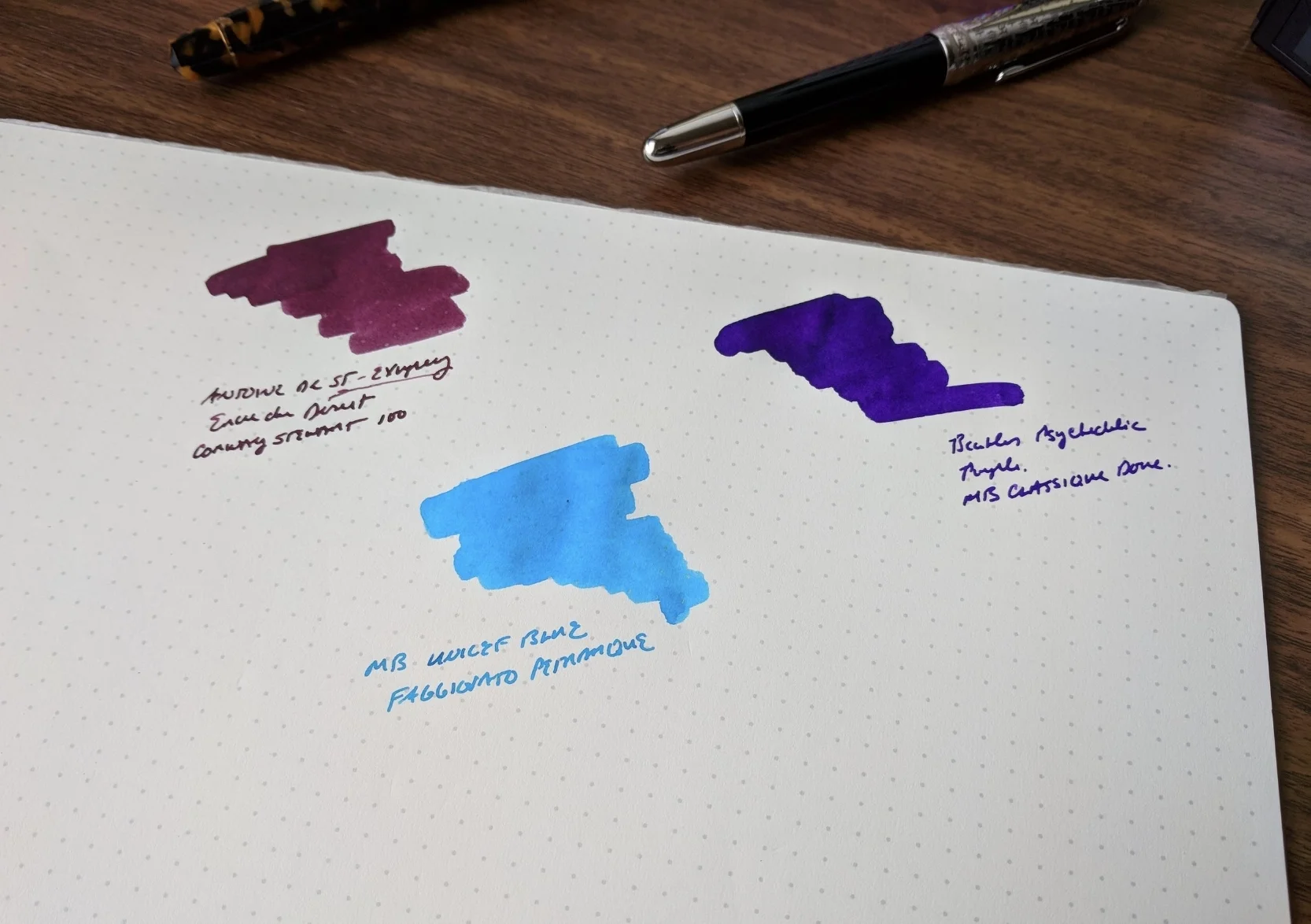I have way too many blue inks, and need to do some serious housecleaning. Part of this, of course, is by default. Over the years I’ve purchased many pens that ship with a bottle of ink, and nine times out of ten, it’s a bottle of “house brand” blue or black. But at the same time, I’ve fallen into the habit of constantly searching for that perfect shade of blue, even though we all know that’s impossible. I’ve accumulated dozens of blues, many in nearly identical shades, without realizing it.
It goes without saying that I’m going to be selling off a lot of the duplicative bottles very quickly, as those are no-brainer choices to let go. Some of the rest, however, are more difficult. Here are my takeaways from this latest round of swabbing inks:
A General Note:
I found the blue inks more difficult than the other color ranges to photograph correctly, especially where you have shades of standard blue, turquoise, and blue-blacks together, and where certain supposedly “blue” inks tend to lean heavily green or teal. The blue-blacks are represented fairly accurately here. Otherwise, these photos tend to slightly overstate the vibrancy of the standard blues and understate the vibrancy of the teals and turquoises.
From Top: Vintage Montblanc Blue-Black; Montblanc JFK Navy Blue; Vintage Pelikan Blue-Black; Sailor Bungubox 4B; Platinum Blue-Black; Pilot Iroshizuku Shin-Kai; Pelikan Edelstein Tanzanite; Lamy Blue-Black; Waterman Blue-Black; Waterman Black-Inspired Blue Mix; Pilot Iroshizuku Tsuki-Yo; TWSBI Blue-Black; TWSBI Midnight-Blue; Aurora Blue-Black; Diamine Cult Pens Deep-Dark Blue.
With Respect to Blue-Black Inks:
I’m much more of a “midnight/navy blue” person than a steel blue, iron gall fan. I intend to move on from inks that essentially dry grey. Farewell, vintage Pelikan Blue-Black, Lamy Blue-Black, Iroshizuku Shin-Kai, and others that have very little actual blue in them.
I’ll probably keep at least one or two bottles of iron gall ink in the collection because it works so well on cheap paper and I sometimes like to use them for work. I don’t need six bottles though, and TWSBI Blue-Black is an inexpensive favorite.
From Top: Noodler’s Air Corps Blue-Black; Papier Plume Midnight Blue; Pilot Iroshizuku Asa-Gao; Pilot Iroshizuku Ajisai; Caran d’Ache “Klein Blue” limited edition; Caran d’Ache Chromatics Idyllic Blue; Graf von Faber-Castell Royal Blue; Graf von Faber-Castell Cobalt Blue; Noodler’s Blue; Sailor Kobe Nagasawa No. 37; Aurora Blue; Robert Oster Fire & Ice; Platinum Mix-Free Aurora Blue; Platinum Mix Free Aqua Blue.
With Respect to “Standard” Blue Inks:
Standard Pelikan, Lamy, and Pilot blue inks are far too washed out to warrant taking up space in the collection. If you’re a serious vintage pen collector, which I’m not, you may prefer one or more of these “safe inks” for use in your more delicate pens prone to staining, but it’s not an issue I face, and in any event I prefer Waterman Florida (“Serenity Now”) Blue.
Aurora Blue remains a favorite inexpensive blue ink. Noodler’s Blue is also very good, and I’ve found it to be better behaved than other Noodler’s colors. It also dries fairly quickly and doesn’t smear. (At least, the bottle I have doesn’t. As with most Noodler’s ink, there are batch variations so YMMV.)
The Pilot Iroshizuku line has the best blue inks across the board of any ink line on the market. I could happily live in this ink lineup forever. Asa-Gao, Ajisai, and Kon-Peki are exceptionally vibrant blue inks that have become staples in my rotation.
I don’t like Sailor blues as much as I used to. I don’t find them as vibrant as the Pilot inks, and even Bungubox Sapphire (which I used to think was the best blue ever) can’t hold a candle to Asa-Gao, IMHO. The ridiculous price point of the Sailor Bungubox inks make this an even easier call.
From Top: Bungubox Sapphire; Leonardo Blue; Pelikan Edelstein Sapphire; Pilot Blue; Omas Turquoise; Montblanc UNICEF Blue; Sailor Ink Studio 140; Sheaffer Turquoise; Franklin-Christoph Spanish Blue; Lamy Blue; Pelikan 4001 Turquoise; Montblanc Elixir “Azure”; Pilot Iroshizuku Kon-Peki; Pelikan Blue; TWSBI Sapphire Blue.
With Respect to Teal and Turquoise:
The big winner from this round of swatching is once again an Iroshizuku ink. Ama-Iro, which I’ve never used before, is absolutely gorgeous. A close second is the standard Pelikan 4001 Turquoise, which also shocked me with its vibrancy.
Iroshizuku Ku-Jaku over Sailor Yama-Dori. Again, Pilot also wins in the category of “dark teal inks with shading.”
Many turquoise inks are too watery for my taste. The one lighter ink I may make an exception for is Sailor Ink Studio 140, since it’s a relatively rare example of a “double shader” that is legible enough for everyday writing.
From Top: Pilot Iroshizuku Ama-Iro; Pilot Iroshizuku Ku-Jaku; Sailor Jentle Yama Dori; Sailor Jentle Naoi-Sumire; Birmingham Pen Company Angelfish; Scribo Blue Cosmico; TWSBI Sky Blue.
So. Many. Blue. Inks.
As always, watch the “Gently Used” Page in the coming weeks. I plan to aggressively unload some of these inks, cycling them through the Patreon first and then move them over to the public sale page after a week. Some greens and pinks still remain from my prior ink testing marathons, along with vintage pencils and office supplies that I’m clearing out.
Disclaimer: This post does not contain paid affiliate links. Going forward, T.G.S is supported entirely by purchases from the T.G.S. Curated Shop and the T.G.S. Patreon Program, which offers access to online meetups, exclusive discounts and pre-orders, and more!





